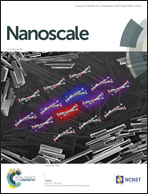Nanoscale investigation of a radial p–n junction in self-catalyzed GaAs nanowires grown on Si (111)
Abstract
One obstacle for the development of nanowire (NW) solar cells is the challenge to assess and control their nanoscale electrical properties. In this work a top-cell made of p–n GaAs core/shell NWs grown on a Si(111) substrate by Molecular Beam Epitaxy (MBE) is investigated by high resolution charge collection microscopy. Electron Beam Induced Current (EBIC) analyses of single NWs have validated the formation of a homogeneous radial p–n junction over the entire length of the NWs. The radial geometry leads to an increase of the junction area by 38 times with respect to the NW footprint. The interface between the NWs and the Si(111) substrate does not show any electrical loss, which would have led to a decrease of the EBIC signal. Single NW I–V characteristics present a diodic behavior. A model of the radial junction single NW is proposed and the electrical parameters are estimated by numerical fitting of the I–Vs and of the EBIC map. Solar cells based on NW arrays were fabricated and analyzed by EBIC microscopy, which evidenced the presence of a Schottky barrier at the NW/ITO top contact. Improvement of the top contact quality is achieved by thermal annealing at 400 °C, which strongly reduces the parasitic Schottky barrier.



 Please wait while we load your content...
Please wait while we load your content...